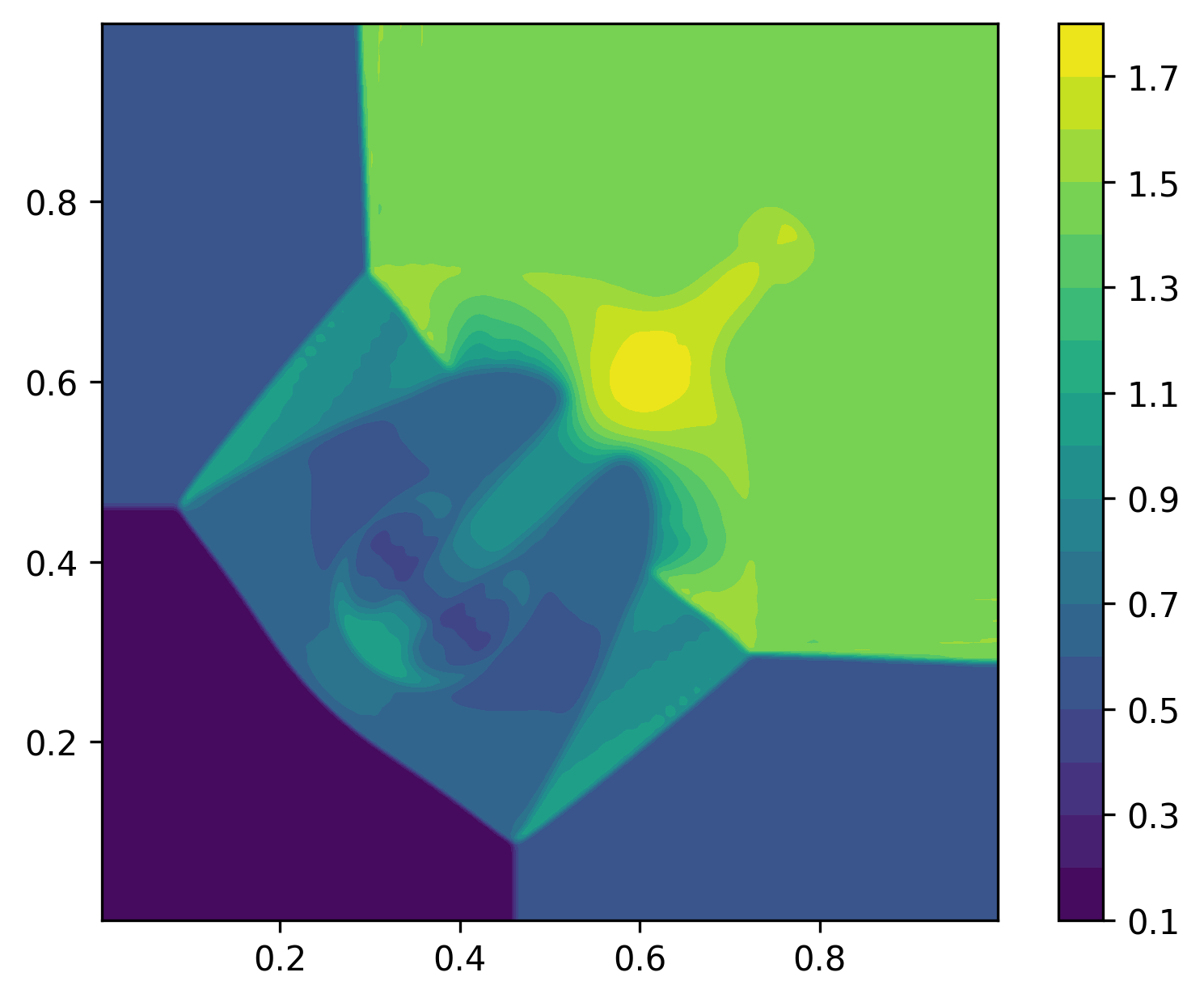2D Euler Riemann#
This problem solves the 2D conservative Euler equations
where the pressure \(p\) is related to the conserved quantities through the equation of the state
Various initial conditions are supported, with various default parameterizations:
icId==1:Accepts the following user-specified parameters
riemannTopRightPressure: pressure in the upper right quadrant (default: 0.4)
Default setting follows those on page 15 of paper1
\(\left\{\begin{matrix}\rho = 0.5313, u = 0, v = 0, p = 0.4; & x\geq 1/2, y\geq 1/2\\ \rho = 1, u = 0.7276, v = 0, p = 1; & x<1/2, y\geq 1/2 \\ \rho = 4/5, u = 0, v = 0, p = 1; & x<1/2, y<1/2 \\ \rho = 1, u = 0, v = 0.7276, p = 1;& x>1/2, y<1/2 \end{matrix}\right.\)
This IC is used to create the corresponding initial conditions in conservative variables.
Time integration is performed for \(t \in (0, 1/5)\)
icId==2:Accepts the following user-specified parameters
riemannTopRightPressure: pressure in upper right quadrant (default: 1.5)riemannTopRightXVel: x-velocity in upper right quadrant (default: 0.0)riemannTopRightYVel: y-velocity in upper right quadrant (default: 0.0)riemannTopRightDensity: density in upper right quadrant (default: 1.5)riemannBotLeftPressure: pressure in lower left quadrant (default: 0.029)
The remaining, unspecified primitive state values are computed following the compatibility relations provided by Configuration 3 of paper2
Default settings follow those in configuration 3 of paper3
\(\left\{\begin{matrix}\rho = 1.5, u = 0, v = 0, p = 1.5; & x\geq 4/5, y\geq 4/5\\ \rho = 0.5323, u = 1.206, v = 0, p = 0.3; & x<4/5, y\geq 4/5 \\ \rho = 0.138, u = 1.206, v = 1.206, p = 0.029; &x<4/5, y<4/5 \\ \rho = 0.5323, u = 0, v = 1.206, p = 0.3;& x>4/5, y<4/5 \end{matrix}\right.\)
This IC is used to create the corresponding initial conditions in conservative variables.
Time integration is performed for \(t \in (0, 4/5)\)
By default, \(\gamma = 1.4\)
Domain is \([0, 1]^2\) with homogeneous Neumann on all boundaries
Mesh#
python3 pressio-demoapps/meshing_scripts/create_full_mesh_for.py \
--problem riemann2d_s<stencilSize> -n Nx Ny --outDir <destination-path>
where
Nx, Nyis the number of cells you want along \(x\) and \(y\) respectively<stencilSize> = 3 or 5 or 7: defines the neighboring connectivity of each cell<destination-path>is where you want the mesh files to be generated. The script creates the directory if it does not exist.
Important
When you set the <stencilSize>, keep in mind the following constraints (more on this below):
InviscidFluxReconstruction::FirstOrderrequires<stencilSize> >= 3InviscidFluxReconstruction::Weno3requires<stencilSize> >= 5InviscidFluxReconstruction::Weno5requires<stencilSize> >= 7
C++ synopsis#
#include "pressiodemoapps/euler2d.hpp"
int main(){
namespace pda = pressiodemoapps;
const auto meshObj = pda::load_cellcentered_uniform_mesh_eigen("path-to-mesh");
const auto probId = pda::Euler2d::Riemann;
const auto scheme = pda::InviscidFluxReconstruction::FirstOrder; //or Weno3, Weno5
auto problem = pda::create_problem_eigen(meshObj, probId, scheme [, icId, userParams]);
auto state = problem.initialCondition();
}
Where the icId is an integer identifying the initial condition above, and userParams is an std::unordered_map<std::string, decltype(meshObj)::scalar_type> mapping user-specified parameter names to their designated values (see above for valid parameter names and their default values for each icId).
Python synopsis#
import pressiodemoapps as pda
meshObj = pda.load_cellcentered_uniform_mesh("path-to-mesh")
probId = pda.Euler2d.Riemann
scheme = pda.InviscidFluxReconstruction.FirstOrder # or Weno3, Weno5
problem = pda.create_problem(meshObj, probId, scheme [, icId])
state = problem.initialCondition()
Where the icId is an integer identifying the initial condition above.
Sample Plot#
Representative density plot at \(t=4/5\) using icId=2 initial conditions with Weno5,
SSPRK3 time integration:
